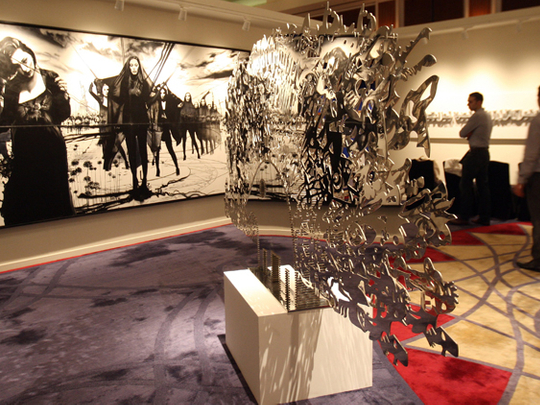
Art buying sounds like a expensive endeavour, but it is not only for the ultra-wealthy and overly educated. Today, a growing number of young, middle-class professionals from the UAE and around the Middle East are putting their money into paintings, sculptures and installations.
Auctioneers, gallery owners and artists in Dubai have observed that more and more young individuals are committing their capital to art, spending about Dh7,000 to Dh30,000 in a single purchase. These buyers are allocating funds to art not just for pleasure, but to feather their nest eggs.
The new breed of buyers has figured prominently at Dubai’s auctions, including the ones hosted by Christie’s and gallery operators. At last month’s
Young Collectors Auction, an initiative by Ayyam Gallery in Dubai, art lovers snapped up a number of Middle Eastern masterpieces worth around $650,000 (Dh2.3 million), more than a threefold growth from the $200,000 raised in 2009, when the first auction was held.
Last year, nearly half (45 per cent) of Christie’s customers participating in global online auctions were newcomers. The London-based auction house recently lowered the price threshold of contemporary Middle Eastern art to as low as $1,500 to attract the young generation.
Global trend
“We’re seeing more and more young collectors participating in art in this region, and it’s a global trend. This segment tends to focus more on young and emerging artists,” said Michael Jeha, managing director at Christie’s Middle East.
Ramin Salsali, an art collector and founder of the Salsali Private Museum, said many of the younger average-income earners from Iran, UAE and European countries are spending on creative pieces, each carrying an average of Dh15,000 price tag.
Art buyers around the world forked over $7 billion for artworks at various Christie’s auctions last year. More than 50 of the sold masterpieces were worth $10 million each.
Part of the appeal of art is that any piece of work, not necessarily by legendary names like Pablo Picasso or Andy Warhol, could yield exponential returns. Many paintings that were bought less than a decade ago at a gallery in Dubai are believed to be worth five to ten times more today.
“The prices are increasing, but you can’t just look at it year to year. Although not every art piece appreciates in value. On average the prices go up about five times every five years,” said Hisham Samawi, co-founder of Ayyam Gallery, which showcases the creations of regional artists across the Middle East.
Wael Hattar, 35, a Jordanian/Lebanese who works in the branded content industry, bought his first piece of fine art in Beirut for $250 in 2005. Last year, his artistic purchases totalled $25,000. Hattar’s personal collection now consists of approximately 40 artworks of mixed media, which now grace the walls and corners of his apartment in Dubai, as well as his parents’ house in Sharjah.
“I’m not selling them now, but I do think of them as a long-term investment because these things could increase in value. It takes a long time to profit from art,” Hattar said.
More young buyers like Hattar have emerged because the art scene in the UAE is fairly new, with galleries and museums opening their doors for the first time and creative events taking place only in recent years. A staple in Dubai’s burgeoning art market, the Alserkal Avenue in Al Quoz that houses a trove of art galleries was launched only in 2008.
“The whole Middle Eastern art scene started only in 2006. That means most people collecting artworks are young,” Samawi told Gulf News.
“There are so many galleries, art fairs and exhibitions being held and museums opening up here and around the region. I think the interest, awareness and appreciation for art are all growing considerably. It’s a natural tendency for younger collectors to start emerging,” added Jeha.
Dr Najat Meky, an Emirati artist hired recently to produce paintings for a boutique hotel property in Al Barsha, pointed out that not everyone is into art for the money. Meky has sold a number of her works to businessmen, public and private enterprises and museums.
“People from the middle-class community are interested in having nice pieces of art at their homes because art is now beginning to have a bigger importance in everyone’s life. And they are willing to pay with the little money they have,” said Meky.












